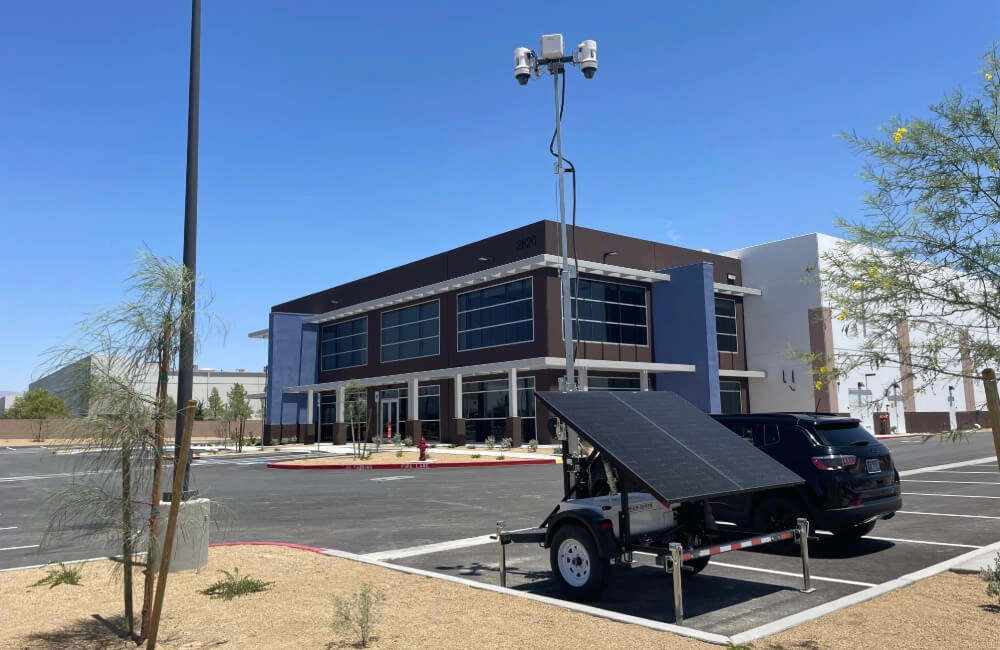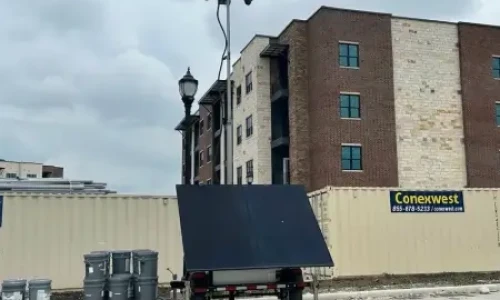There’s approximately 15.57 million vacant properties across the US reported at the beginning of 2025.
Since the end of 2020, vacant property rates have stayed at a similar rate and for criminals, this provides them with various opportunities to commit illegal activity such as theft and vandalism, with ease.
Vacant properties run higher risks to occupied property due to the assumed lack of security which often provides an ease of access and reduced monitoring for any potential intruders.
We explore what makes vacant properties vulnerable to security risks and the main threats you should be on the lookout for.
What is Classed as a Vacant Property?
A vacant property represents real estate assets such as an apartment, house, commercial building or piece of land that is currently unoccupied, with no business, tenants, or residents present there.
Reasons for vacancy may include, foreclosure, repossession, renovation, abandonment, personal reasons, or in between vacancy.
Also, any property intended to be demolished or condemned is covered by this term too.
Examples of properties or buildings that would fall under the ‘vacant property’ definition are as follows:
- Closed commercial properties
- Unused warehouses, storage spaces or studios
- New builds or apartments that are not yet occupied
- Homes waiting to be sold
- ‘Zombie’ properties such as abandoned homes or buildings in foreclosure
- Damaged, neglected or structurally unsound properties
The number of vacant properties will vary based on the season also, with summer associated as the peak vacancy period in the US. This is mostly due to the residential and rental market.
Why are Vacant Properties Vulnerable to Security Risks?
Vacant properties face substantially greater risks in comparison to occupied ones.
It is estimated that vacant properties are 3 to 5 times more likely to face theft and vandalism, and at much higher risk of squatting due to the lack of occupancy.
However, in addition to the lack of occupancy, there are several other factors that contribute to vacant properties’ increased vulnerability:
- Lack of maintenance like overgrown gardens, structural damage and uncollected mail all show signs of neglect and reduced monitoring.
- Some vacant properties are based in secluded locations, meaning less surrounding properties and potential witnesses to crime.
- Weakened physical defenses will often be in place with vacant properties allowing for ease of access compared to occupied property.
- Assumed lack of surveillance provides potential intruders with a sense of safety regarding their identity and keeping criminal activity under wraps.
Essentially, most intruders and criminals will be looking for easy targets, and occupied properties present too many obstacles to overcome, making vacant properties extremely enticing for them.
However, for property management companies and owners, the financial burden and legal repercussions of security breaches can become costly in more ways than one.
The Main Threats to Vacant Properties
From clean-up fees and increased insurance premiums to legal bills and lowered property value, security breaches on vacant property are more costly than can be initially imagined.
We explore the main threats to vacant properties and buildings and the vulnerabilities related to each of these in more detail:
Property Theft and Vandalism
The combination of lack of occupancy, reduced visibility and reduced monitoring, place vacant properties as perfect targets for theft and vandalism.
Rising metal prices have led vacant properties to become bigger targets for theft in particular.
Appealing materials such as metal, copper wiring, HVAC units, appliances and piping are all high in demand, and are especially present in commercial properties.
Thieves and Organized Crime Gangs (OCGs) generally search for quick wins that avoid placing them at too much risk, and vacant properties provide that.
Vandalism is also common with vacant property due to their often neglected nature.
Properties showing signs of wear and tear or damage are more likely to be targeted for vandalism as there’s an assumed lack of surveillance and monitoring.
Although insurance should protect from the financial implications of theft and vandalism, it doesn’t stop your insurance premium from increasing.
Squatting
The legal grey area surrounding squatting and lack of occupancy offers trespassers the opportunity to take advantage of your property or building for this purpose.
Previous reports in Dallas displayed the difficulty of removing squatters from vacant property and high costs associated with this.
To remove 11 squatters from a complex it took a total of 6 months and $150,000 in costs before they could even secure the unit.
The law surrounding squatting varies from State to State, and in some instances squatters are able to seek ownership of the property.
Without any occupants to regularly monitor the property, potential squatters can easily scope out and assess entry to the vacant property or building under complete concealment.
Once in the property, the property is likely to face damages, theft and other consequences that create additional costs.
Fire Hazards and Arson
Fires are more likely to occur at vacant properties, especially residential property, and quite often are committed with intent.
The lack of occupancy and surveillance allows for easier opportunities of arson, as there’s a lower likelihood of capture and identification.
The danger with fires at vacant properties is the greater chance of escalation, and potential damage to the surrounding area, residents and firefighters involved in diffusing the flames.
Vacant properties showing signs of neglect are at heightened risk of arson as this indicates to criminals there is little to no monitoring taking place at the property.
Environmental Damage
Vacant properties are prone to environmental damage including adverse weather, water ingress, illegal dumping and general deterioration.
The Environmental Protection Agency estimates that there are approximately 100,000 illegal dumps in the United States, with environmental damage and clean-up costs exceeding $10 billion.
Financial implications in instances of illegal dumping on vacant property will fall on the property owner or management company, and this can become costly.
Also, where maintenance issues appear, these will often be allowed to worsen and escalate at vacant properties due to fewer checks being completed there.
This will create larger costs and more damage to both the property itself and the surrounding environment, in which you would be held liable for.
Antisocial Behaviour
Antisocial behaviour (ASB) ranges from criminal damage to loud parties, loitering and drug-dealing.
The empty space provided by vacant properties offer the perfect hiding space for criminal gangs to situate themselves and commit illegal activities.
Vacant properties are common places for drug-dealing in particular due to the lowered risk associated with them and reduced monitoring which will help them avoid capture.
ASB covers an umbrella of crimes, most of which will create costly damages or legal bills that you will be responsible for as property owners and managers.
Trespassing
Trespassing can be both a criminal and civil offense, but this doesn’t stop individuals from committing this on your vacant property and any related land.
Large industrial buildings and commercial property are popular for trespassing due to the vast space, historic architecture at times and surveillance management difficulties surrounding them.
The unpredictability of trespassers’ intentions could lead your building or property with damage and a large bill you’ll be expected to cover.
Trespassing also runs the risk of injury and you’ll be surprised to know you could be held liable to any legal fees relating to the injury that took place on your property.
For those intending to sell the property, you may be unable to provide vacant possession if you do not take the necessary steps to protect it from trespassers.
Why Protecting Your Vacant Property’s Perimeter is Important
Most threats are external to your property, so perimeter security is important to prevent any unauthorized access onto your vacant property and subsequent criminal activity that may occur after this.
Protecting your vacant property’s perimeter provides the following benefits:
- Deters criminals from the property and illegally accessing your site
- Prevents theft and property damage by restricting access to your property or building
- Reduces liability risks if a person injures themselves on your property and any related land
- Discourages illegal dumping by informing intruders that the property or building is being monitored
- Shows there is active ownership to prevent squatting and avoid community complaints
There are various ways of protecting your property’s perimeter, from fencing and access control to security guards and surveillance cameras, however, the right solution will depend on various factors.
Overall, the most universal method is mobile surveillance cameras, providing flexible, temporary coverage that works perfectly for vacant property.
Other additional benefits include, high-quality evidence gathering for criminal proceedings, live monitoring of your property’s perimeter and land, and proactive incident response.
However, identifying the right security provider is extremely important as without the correct backing, knowledge, and service, your property may not be protected like you think.

High-Quality Property and Perimeter Security With LotGuard
Being the USA’s leading provider in parking lot surveillance solutions, LotGuard offers complete property perimeter and parking lot security.
A trusted supplier to the property management industry, our Surveillance Trailers support various property and building types, from vacant residential apartment complexes to closed commercial buildings.
Standing at 20 ft tall, they have strong criminal deterrence that’s unmistakable to any intruders whilst only requiring one parking spot for deployment.
Their complete power autonomy allows them to reach vacant properties and buildings in even the most secluded locations, without you needing to skimp on the quality of security you receive.
Backed by remote monitoring services, they provide proactive incident response via trained security professionals, who keep track of any motion, review it, and then respond appropriately to provide the best chance of prevention and crime interception.
This specifically targets issues like squatting as in order to stop this, you need to be quick in your response to stop from entering the property or building in the first place.
There are various benefits to deploying parking lot surveillance solutions that go beyond the protection of vehicles.
To discover how our range could support you and your vacant property’s needs, speak with one of our experts today!
Contents
[hide]Related news
Contact Us
Request a Quote for LotGuard
Ready to learn more about how LotGuard can protect your Parking Lots and Properties? Get in touch today for a free quote.





